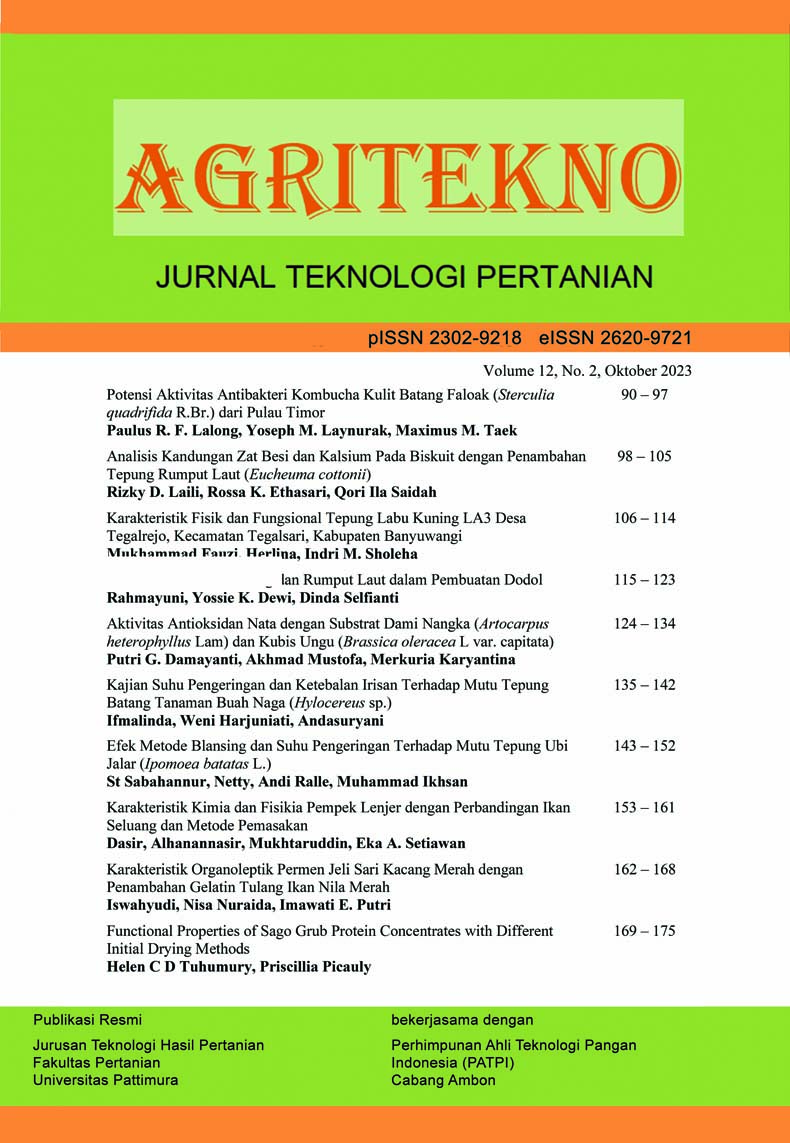Karakteristik Organoleptik Permen Jeli Sari Kacang Merah dengan Penambahan Gelatin Tulang Ikan Nila Merah
Organoleptic Characteristics of Jelly Candy Red Beans Extract with the Addition of Nile Bones Gelatin
Abstract
This study aimed to determine the organoleptic characteristics of red bean extract based on jelly candy with the addition of nile bones gelatin. This study used a completely randomized design with factorial experiments. The first factor is Nila-bones gelatin concentration which consists of concentration levels A1 (10 g) and A2 (13 g). The second factor was the addition of red bean extract to replace water which consisted of 3 levels, namely B1 (50%), B2 (70%), and B3 (100%). Data analysis of organoleptic used the Kruskal-Wallis test. When p < 0.05, will be continued by the Mann Whitney test at the real level α 5%. The results showed that the addition of Nila-bones gelatin to jelly candy based on red bean extract had a significant effect (p < 0.05) on the quality and level of overall panelist preference. A1B2 (10 g of gelatin; 70% of red bean extract) is the formula for the selected jelly candy red bean extract.
Downloads
References
Agustin, A. T. (2013). Gelatin ikan: sumber, komposisi kimia dan potensi pemanfaatannya. Media Teknologi Hasil Perikanan, 1(2), 44–46. https://doi.org/10.35800/mthp.1.2.2013.4167
Agustini, T. W., Widayat, W., Suzery, M., Darmanto, Y., & Mubarak, I. (2020). Pengaruh jenis ikan terhadap rendemen pembuatan gelatin dari ikan dan karakteristik gelatinnya. Indonesia Journal of Halal, 2(2), 46–52.
Amin, M., Novitasari, R., & Mardesci, H. (2018). Studi perbandingan kacang merah (phaseolus vulgaris L.) dan rumput laut (Euchema cottonii) terhadap karakteristik permen jelly. Jurnal Teknologi Pertanian, 7(1), 21–32.
Bactiar, A., Ali, A., & Rossi, E. (2017). Pembuatan Permen jelly ekstrak jahe merah dengan penambahan karagenan. Jurnal Online Mahasiswa, 4(1), 10–27.
BSN. (2008). SNI 3547.2-2008 Kembang gula – Bagian 2 : Lunak. Jakarta: BSN RI
Fajarini, L. D. R., Ekawati, I. G. A., & Ina, P. T. (2018). Pengaruh penambahan karagenan terhadap karakteristik permen jelly kulit anggur hitam (Vitis vinifera). Jurnal Ilmu dan Teknologi Pangan (ITEPA), 7(2), 43. https://doi.org/10.24843/itepa.2018.v07.i02.p05
Harjanti, S. W. (2013). Pembuatan Yoghurt Kacang Merah (Phaseolus vulgais L) dengan Penambahan Ekstrak Bunga Rosela (Hibiscus sabdariffa L) sebagai Pewarna Alami. Skripsi. Universitas Muhammadiyah Surakarta.
Hidayat, G., Dewi, E. N., & Rianingsih, L. (2016). Characteristics of bone gelatin tilapia (Oreochromis niloticus) processed by using hydrolysis with phosphoric acid and papain enzyme. Jurnal Pengolahan Hasil Perikanan Indonesia, 19(1), 69–78. https://doi.org/10.17844/jphpi.2016.19.1.69
Kumalaningsih, S., Pulungan, M. H., & Raisyah, R. (2016). Substitusi sari kacang merah dengan susu sapi dalam pembuatan yogurt. Industria: Jurnal Teknologi dan Manajemen Agroindustri, 5(2), 54–60. https://doi.org/10.21776/ub.industria.2016.005.02.1
Mardawita, P. (2015). Pengaruh Pemanfaatan Kacang Merah (Phaseolus vulgaris L.) dalam Pembuatan Permen Jelly Terhadap Mutu Organoleptik dan Kadar Protein. Karya Ilmiah. Politeknik Kesehatan Kemenkes Padang.
Mufida, R. T., Darmanto, Y. S., & Suharto, S. (2020). Karakteristik permen jelly dengan penambahan gelatin sisik ikan yang berbeda. Jurnal Ilmu dan Teknologi Perikanan, 1(1), 29–36. https://doi.org/10.14710/jitpi.2020.8086
Muflih, A. (2014). Gelatin ikan dan pemanfaatannya. Samakia: Jurnal Ilmu Perikanan, 5(2), 105–107.
Nelwwan, B., Langi, T., Koapaha, T., & Tuju, T. (2015). Pengaruh konsentrasi gelatin dan sirup glukosa terhadap sifat kimia dan sensoris permen jelly sari buah pala (Myristica fragrans houtt). Journal Cocos, 6, 1–10.
Nurismanto, R., Sudaryati, & Ihsan, A. H. (2015). Konsentrasi gelatin dan karagenan pada pembuatan permen jelly sari brokoli (Brassica oleracea). Jurnal Teknologi Pangan, 9(2).
Persagi. (2009). Tabel Komposisi Pangan Indonesia. Jakarta: PT. Gramedia.
Putri, I. E., Iswahyudi, I., & Nuraida, N. (2022). Sifat fisik permen jeli berbasis gelatin tulang ikan nila merah (oreochromis niloticus) dengan penambahan sari kacang merah (Phaseoulus vulgaris L.). Jurnal Teknologi dan Mutu Pangan, 1(1), 34–39. https://doi.org/10.30812/jtmp.v1i1.2177
Ramadani, D. T., Dari, D. W., & Aisah, A. (2020). Daya terima permen jelly buah pedada (Sonneratia caseolaris) dengan penambahan karagenan. Jurnal Akademika Baiturrahim Jambi, 9(1), 15. https://doi.org/10.36565/jab.v9i1.151
Rohmah, A., Larasati, D., & Fitriana, I. (2022). Substitusi susu kacang merah (Phaseolus vulgaris L.) terhadap karakteristik fisik, kimia, dan organoleptik susu jagung manis (Zea mays L. saccharata Sturt). Jurnal Mahasiswa Teknologi Hasil Pertanian, 11, 1–6.
Sandria, N., Desmelati, & Sukmiwati, M. (2014). Studi ekstraksi gelatin dari mata ikan tuna (Thunnus sp.). Jurnal Online Mahasiswa, 1, 1–11.
Setyaningsih, D., Apriyantono, A., & Sari, M. P. (2010). Analisis Sensori untuk Industri Pangan dan Argo. Bogor: IPB Press.
Simanungkalit, H., Indriyani, & Ulyarti. (2016). Pembuatan es krim dengan penambahan kacang merah (Phaseolus vulgaris L.). Jurnal Penelitian Universitas Jambi Seri Sains, 18(1), 20–26.
Suprapti, L. (2004). Jelly Jambu Mete. Jawa Tengah: Kanisius
Tilohe, R. S., Lasindrang, M., & Ahmad, L. (2020). Analisis peningkatan nilai gizi produk wapili (waffle) yang diformulasikan dengan tepung kacang merah (Phaseolus vulgaris L.). Jurnal Teknologi Hasil Pertanian, 4(1), 12.
Uswatun, A. (2011). Kandungan gizi dan serat pada pembuatan es krim kacang merah. Tugas Akhir. Universitas Negeri Yogyakarta.
Copyright (c) 2023 The Author(s)

This work is licensed under a Creative Commons Attribution-ShareAlike 4.0 International License.
Authors who publish with this journal agree to the following terms:
- Authors retain copyright and grant the journal the right of first publication with the work simultaneously licensed under a Creative Commons Attribution License that allows others to share the work with an acknowledgement of the work's authorship and initial publication in this journal.
- Authors are able to enter into separate, additional contractual arrangements for the non-exclusive distribution of the journal's published version of the work (e.g., post it to an institutional repository or publish it in a book), with an acknowledgement of its initial publication in this journal.
- Authors are permitted and encouraged to post their work online (e.g., in institutional repositories or on their website) prior to and during the submission process, as it can lead to productive exchanges, as well as earlier and greater citation of published work (See The Effect of Open Access).









